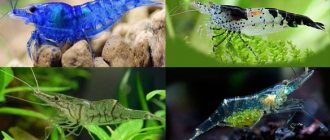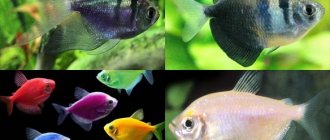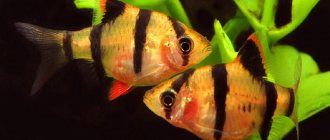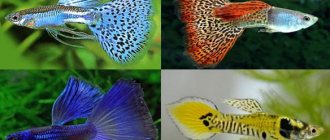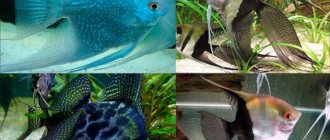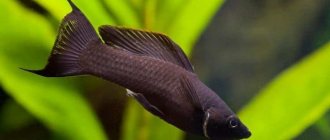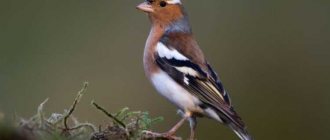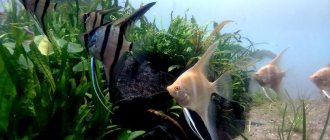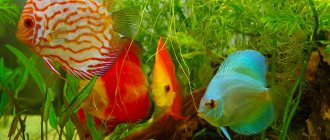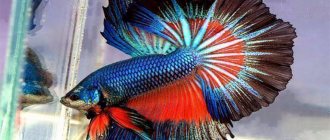Cichlids are loved by home aquarium owners for their diversity of species, bright colors and unusual habits. This is the only fish capable of recognizing its owner and carefully caring for its offspring.
In addition, family values are not alien to her, because this fish chooses a partner for life. Cichlids can breed in an aquarium and live quite a long time.
Cichlids
The Cichlid family includes up to 3,000 species, which are distributed throughout the world. Almost half of them live in lakes and rivers of Africa, but colorful fish are also found in the warm rivers of South America and Asia.
They began to breed exotic pets in artificial reservoirs since the times of ancient Egypt, but in Russia and Europe they appeared only in the 20th century, they fell in love with lovers and breeders, who began to breed original and beautifully colored breeds, choosing the most peaceful species.
Cichlids in nature live in fresh or slightly salty lakes and rivers. They belong to the family of ray-tailed fish, the order of perciformes, and have sizes from 2.5 cm to a meter. The main part of Cichlids has a tall body, slightly flattened, with a large head. The commercial breed Tilapia belongs to the same family. The lifespan of fish reaches 10-15 years in an aquarium, in nature up to 20-25 years.
Table of basic parameters of maintenance, care and nutrition:
| What should be the volume of an aquarium for Cichlids? | from 150-300 liters |
| What should be the temperature in the aquarium for Cichlids? | from +20-28 °C |
| What pH should be in the aquarium? | from 6-8 pH |
| What should be the hardness of the water in the aquarium? | from 5-15° dH |
| What should be the substrate for an aquarium? | any |
| What kind of lighting should be in the aquarium? | moderate |
| What should be the movement of water in the aquarium? | moderate |
| Maximum fish size | from 2.5 cm to a meter (depending on the type) |
| What does aquarium fish eat? | depends on the type: aquarium plants; dry food; live food: daphnia, tubifex, bloodworms |
| Type of aquarium fish | aggressive |
| Who is compatible with in an aquarium? | get along with all non-aggressive fish species that do not fit in the mouth |
| Lifespan | up to 10-15 years |
African species
Most of the cichlids live on the African continent. The main habitats of these fish are some of the largest lakes in the world - Malawi, Tanganyika, Victoria, as well as other lesser known ones. In addition to lake species, there are also river species. The appearance of African cichlids is very diverse.
Most have an elongated, slightly flattened body. The fins of males are long, with sharp edges, while those of females are more rounded.
Some species have a growth on the head or a slightly elongated mouth.
Most species have spectacular, bright colors, which help to distinguish relatives from representatives of other species.
- Pelvikachromis pulcher or parrot cichlid has an elongated, slightly flattened body of yellow-brown color with a scarlet spot on the belly and small bright dots on the fins. In an excited state or during spawning, the color becomes more saturated. Parrots grow relatively small, males - about 10 cm, and females - up to 7 cm. The average life expectancy is approximately 5 years. It has a rather peaceful character.
- Hemichromis aureus is an inhabitant of ponds and rivers in western Africa. The body of the fish is elongated and flattened on the sides, the head has a high forehead and thick lips. The color is yellow-green, the belly is yellowish or faint red. There are 5 dark spots on the sides and gills. During spawning, the color of the fish becomes golden in color, and the abdomen becomes scarlet. On average they live up to 10 years, the maximum length becomes 15 cm.
- Hemichromis red is similar in description to the previous representative of cichlids, but differs in color. The fish has a bright red body with numerous bluish dots; they are even present on the fins. Males are slightly larger in size, and as they mature, they develop a growth on their head. Females have a lighter color and fewer spots. On average they grow up to 10 cm.
- Haplochromis cornflower is an inhabitant of Lake Malawi. It is distinguished by its unusual blue color. The lower fin of the fish is yellowish in color, the dorsal fin is different in length, and on it, like on the tail, there are several small yellow spots. Adults reach 20 cm, both males and females.
- Due to its rather scattered habitats, Haplochromis philander The largest representatives (about 11 cm) have a yellowish-green color with a golden tint, but the back and sides have a light blue tint, the body is covered with blurry stripes, turning into spots in the tail. Fish with smaller sizes (8 cm) are distinguished by a yellowish-olive color (males) and a clay-yellow color (females). The fins have small greenish dots, and the male has a bright red spot near the anal fin.
Males of the smallest representatives of the philander from Southeast Africa (up to 8 cm) have the same color as their medium-sized relatives, only with a pronounced blue tint; females are also similar.
- Frontosa is an inhabitant of the sandy bottom of Tanganyika. The body of the fish is long, with flattened sides and a high back; a characteristic growth appears on the head of adult individuals. The body color of the frontosa can vary from grayish-white to gray-blue; on the sides there are six transverse stripes of different widths of a dark tone. This type of fish is distinguished by its phlegmatic character and inactivity.
- Tropheus stellate is distinguished by a slightly elongated, arched body. The main color is black and blue, on the sides between the fins - the ventral and the beginning of the dorsal - there is a yellow, rather wide stripe located across. The fins are dark in color with black-blue edges and dots of a pale yellow hue. Can grow up to 12 cm.
- Pseudotropheus Pindani has an elongated body of a soft blue color, sometimes with a slight purple tint. The fins have dark blue rays. There are several yellow spots on the anal fin of males. Males are larger than females, but their colors are the same.
- Pseudotropheus zebra is distinguished by an elongated, slightly laterally compressed body and a fatty formation on the head. The species is characterized by an extraordinary color palette - about 50 color options: white, blue, red, yellow, orange. There are 7-9 transverse darker stripes on the sides.
- Pseudotropheus lombardo has a yellow-golden or yellow-brown color; in some cases, not very clear stripes are noticeable on the sides. The fins have a light blue tone, the anal fins are decorated with yellow dots, and the dorsal fins have a white edge. The fish reach 15 cm in length.
- Lamprologus are represented by several species, a characteristic feature common to all of them is an elongated body, but the colors are completely different. Lamprologus blue has an elongated body of a bluish tone with five black stripes across the sides; there is also a line of the same color on the forehead. Because of its color, it is also called the five-striped zebra. The length of males is about 15 cm, females have smaller parameters.
- Lamprologus ribbon shell can have several colors: blue, brown, yellowish or creamy orange; there are 9 thin silver stripes on the body.
- Lamprologus orange is distinguished by three color options: orange, golden yellow or blackish with numerous light spots.
- Lamprologus ocellata has a light brown body, on which 3 rows of shiny scales are placed in a longitudinal order.
- Labidochromis yellow, also called lemon or hummingbird, belongs to the dwarf species of cichlids. Individuals of both sexes have a yellow color; in the dominant males it is more saturated, and, in addition, their fins are black, with a yellow edging on the back. Females have yellow fins.
- The golden leopard has a flattened body and a high back. The main background is whitish-yellow, the whole body is covered with large spots of olive green and black stripes. The dorsal fin has a golden edge, and the caudal fin is yellowish-orange. When the male becomes sexually mature, his color changes completely, spots and stripes disappear, and his head and belly acquire a blue tint. The body becomes more yellow with slightly noticeable, blurred small spots.
- Melanochromis golden auratus has different color options for individuals of different sexes. Males have a brownish-black body and a golden back; on the sides there are 2 parallel blue horizontal stripes along the entire body. The fins are white-yellow or blue, with 1-2 light dots located on the anal fin.
The color of females is golden yellow with brown stripes. The yellow fins also have brownish lines, and the tail is decorated with black spots.
- The blue dolphin has a rather tall, slightly compacted body and a large head with a characteristic convex forehead (in adult males) and thick lips. Young representatives of the dolphin are characterized by a gray-blue color with a slight silvery sheen and dark stripes on the sides. In adult fish, the color of the fins and body is velvety blue. During spawning, the bulge on the male's forehead turns yellow.
- Aulonocara Benshi is characterized by a strongly flattened body of an elongated shape. The male’s forehead and body are yellow, but the mouth, cheeks and gills are purple, with 7-9 purple stripes located vertically on the sides. The female has a dark brown color with 8-9 dark stripes. Aulonocara grow up to 12 cm in length.
- The red kadango has a large head and mouth, with which it swallows large portions of water with plankton. In different parts of Lake Malawi, there are several varieties of kadango, which differ in color. Representatives of the Kadango with a bluish head and a yellowish or red body are popular as aquarium fish. Some fish have 3 black spots on both sides. Females are smaller and predominantly grayish in color.
- Maingano is also a dwarf cichlid species with an elongated body and a rounded head. There is a low fin along the entire back. The color of the fish is dark blue with two stripes located horizontally and having a blue color. The edges of the fins and tail are bordered by a thin bluish stripe.
Aquarium fish Cichlids: maintenance and care
Breeders have bred a large number of species of Cichlids, differing from each other in appearance, body shape and habits. Fish can be painted in a wide variety of colors: white, pearlescent, blue, green, pink. Different species have their own patterns on the sides: longitudinal or transverse stripes, specks, dots. The body shape of different species is different: elongated, circular, flat. The character of the fish is also not the same; they can be quarrelsome and peaceful.
Caring for Cichlids is not too complicated, but it requires following some rules:
- the volume of the aquarium should be from 150-300 liters;
- be sure to provide grottoes, caves, houses so that the fish can hide;
- make sure that the constant water temperature is +20-28° C, but for some species the temperature can be from +28-30° C;
- acidity 6-8 pH;
- hardness from 5-15° dH;
- the water must be clean, partial replacement is necessary 2 times a week, the water should not be too hard;
- filter water, install an aeration system;
- It is better to make the aquarium a species one by placing a family of one male and several females there. You should not put several males of the same species into one aquarium; they will destroy each other.
You should not plant aquarium plants in the tank, the fish will tear them to pieces. It is worth giving preference to artificial bushes; it is better to pour sand on the bottom. A lid with artificial lighting should be installed on top; the light should be diffused and not too bright.
Unsuitable roommates
Cichlids are considered predatory fish, so many species do not get along with them. Most representatives of cichlids cannot tolerate small, slow neighbors.
You cannot add to ray-finned:
- cockerels;
- swordtails;
- goldfish;
- guppy;
- mollies;
- iris;
- zebrafish;
- gourami;
- telescope;
- platy.
The appearance of strangers in the aquarium causes aggression in cichlids and they can kill them.
Conflict sometimes arises even within the same species. For example, male parrots cannot stand competition and engage in fights with each other, which ends only after the leader destroys the rest of the brothers. Therefore, it is impossible to house several male parrots together.
The Queen of Tanganika is a crown territorial fish!
Some subspecies of cichlids can coexist only with representatives of their own species. Pseudotropheus is ready to attack anyone who gets in the way, and the Queen of Tanganyika, although not so aggressive, does not tolerate the invasion of strangers into her territory. Therefore, it is recommended to keep them separately, forming flocks of several females and one male.
What to feed cichlids
It is important to feed this breed of fish correctly. First of all, you should study what type of food is suitable for a given species, carnivorous, herbivorous or omnivorous. You cannot feed Cichlids only with dry food; the fish need live food.
Herbivorous species happily eat chopped lettuce, spinach, and dandelion; they will not refuse vegetables: cucumber, zucchini, carrots.
Predators need live food, that is, protein food: live bloodworms, cortera, chopped squid, fish, grated beef heart or liver. Omnivorous species consume 30% protein foods, 70% plant foods.
What to feed the fry
The fry that have just emerged from the eggs are fed with ciliates, daphnia, sedge; when they grow up, they are fed with daphnia, live crushed bloodworms, and ready-made food.
Nutrition
Different species of cichlids have individual nutritional requirements, but most representatives are omnivores and happily feast on dry or live food. As a treat, pets are given grated beef or pork heart. Herbivorous fish should be fed plant foods, otherwise the pets will switch to live vegetation and quickly gnaw it. Feeding must be balanced so that the fish grow and develop properly.
How to distinguish a male from a female and their reproduction in an aquarium
Male Cichlids usually have more pronounced colors and are slightly larger than females, but there are breeds in which the females are larger.
With the onset of maturity, males develop a fatty growth on the head in most species, which does not occur in females. Males often have a dark spot on their sides. Pisces are very constant, choosing one partner for themselves.
Various species of Cichlids reproduce well in an aquarium if the proper conditions are maintained. It is better to place the pair in a separate container for the spawning period, provide dim lighting and the desired temperature depending on the species, and do not disturb the fish at this time.
Of all aquatic inhabitants, these fish are the most caring parents. Cichlids dig a hole in the sand or choose a place on a stone, on leaves in a secluded place, lay eggs, fertilize them and protect them from other inhabitants of the aquarium. By moving their fins, the parents create water circulation over the clutch. They remove dead eggs and monitor the condition of the eggs. A litter can reach 2,000 eggs, but not all survive.
African breeds tend to hold the eggs in their mouths to ensure the safety of their offspring. These breeds can have up to 100 eggs. During the ripening period of eggs, they refuse food.
The newly hatched fry stay in a school just below their parents or one of the parents, so the fry feel safe.
Selection of neighbors for cichlids
It is believed that since cichlids are predatory fish with a developed desire to protect their territory, they cannot peacefully coexist with other species in the same aquarium. However, there is also an opposite opinion. Well-fed predators that do not lack food or personal space will not attack even defenseless fry.
For peaceful coexistence of fish, it is important to follow the following rules:
- You cannot place a flock in an aquarium of the wrong size. When selecting fish, you need to calculate the total volume of water in the container relative to the needs of each fish. When an aquarium is overpopulated, herbivorous species will be the first to suffer.
- Feeding fish should be timely and varied. You need to alternate different types of food daily. At the same time, you should not overfeed predatory fish and skimp on herbivores. Starving herbivorous fish will begin to eat algae and plants in the aquarium, which will lead to territorial wars.
- The desire to protect their territory among cichlids is ineradicable. But if you equip the aquarium, dividing it into zones and providing each couple with a spacious home, many fights and the death of fish can be avoided.
- Members of a mixed school have a greater chance of survival if they were introduced into the aquarium at the same time and at a relatively equal age of all fish. Cichlids that grow up in a constant environment of peaceful neighbors quickly get used to them and do not touch them, even as adults. But the new neighbor, who moved in much later, will most likely be quickly eaten.
- The young flock must be carefully monitored. If cichlids nevertheless begin to attack defenseless neighbors, then it is better to immediately resettle the herbivorous fish, without waiting for their death.
Don’t forget to follow 5 rules
If you ask an aquarist what fish cichlids get along with, he will list only three species:
- astronotuses;
- battles;
- blackheads
Cichlids do not get along well with small fish. In addition, they are annoyed by slow neighbors. These predators are considered to be completely incompatible with the following species:
- black telescopes;
- swordtails;
- iris;
- mollies;
- guppy;
- goldfish;
- catfish;
- rasboras;
- carp;
- cockerels;
- tetras;
- zebrafish;
- platies;
- gourami.
On the other hand, cichlids from different regions and different sizes always display their character in their own way. Small species are more peaceful. Asian cichlids are considered the most peaceful and calm. In the golden mean are African fish. “American” cichlids show the most aggression.
There are a number of fish with which they are not compatible
With American cichlids, you can keep fish that will be similar in size to them as adults. These are large handsome chromis and large melanotenias. Freshwater “Africans” of small size will become good neighbors of characoid species and synodontis.
Certain species of cichlids have their own behavioral habits in relation to neighbors of a different type:
- Cichlasoma Meeka and black-striped cichlasoma are not aggressive towards those fish with which they are kept in a common aquarium from juvenile age, provided that shelters are equipped for pairs.
- The eight-striped cichlazoma is more aggressive and only gets along with medium-sized neighbors.
- Cichlazoma severum calmly coexists next to any fish.
- Astronotuses raised in a community aquarium form their own cichlid flock and completely ignore all other types of fish, so even guppies are calmly housed with them.
- Apistogramma Ramirez (butterfly fish) does not attack even the smallest fish.
- Large parrots, reaching up to 8 cm in length, are peaceful towards almost everyone and always, but only until a stranger invades their territory. They usually show territorial instincts during spawning and before the fry grow up.
- Chromis beauties are aggressive, but may not touch the fish with which they grew up. They exhibit a very highly developed parental instinct. There is a known case when the owner resettled Chromis fry in order to protect them from attacks by other fish. The fry were placed in a separate container, which was placed in the “parent” aquarium in free swimming mode. A pair of chromis that gave birth to fry recognized them through the glass and began to drive other fish away from the container in order to save their offspring. This confirms the theory that fish are able to recognize their children by external signs without any auxiliary elements such as odors or signaling substances. At the same time, chromis always eat extraneous fry.
- Widespread angelfish almost never attack their neighbors.
- The Japanese parrot (Teraps) does not like small fish; it chases its medium-sized neighbors, but does not eat them.
- Melanochromis Johana ignores fish of other species; the formed pair separates from “their own” and tries to drive away fish of their own species.
- The Golden Parrot is safe for small and large fish and is forgiving towards the fry of other pairs.
- The Princess of Burundi is an insectivorous species that does not attack other fish and always stays in a school. This also applies to the spawning period. The young of all pairs are mixed and raised by the entire flock at the same time.
- The blue dolphin grows as long as the aquarium allows. The maximum recorded length is 25 cm. But even being so large, it coexists perfectly with small and medium-sized non-predatory neighbors.
- Pseudotropheus Lombarde is conditionally aggressive. Only males fight, and only with representatives of their own species. Females and other fish species are safe around them.
- The Queen of Tanganyika are huge (up to 35 cm) representatives of the cichlid family, which not only peacefully relate to other fish, but also often suffer from much smaller aggressors. They always try food for a long time and wonder whether it is worth eating. During this time, the more nimble neighbors manage to steal the food right from under their noses. The owner of the aquarium needs to feed the Tanganyika queen separately and make sure that no one attacks her.
This is an incomplete list of cichlids. Each aquarist can choose residents for his aquarium in accordance with his personal capabilities and preferences. It is worth remembering that some species are very rare and expensive. But the problem of combining different fish with the right approach is completely solvable.
In this video you will learn more about these fish:
Cichlids compatibility with other fish
Before getting fish of this breed, you should study the issue of Cichlid compatibility with other inhabitants of the aquarium. It is better to keep them separately, as they have a difficult character and can be aggressive.
Acara, Discus, and Angelfish have the most peaceful disposition. Cichlids get along well with Swordtails, Mellinesia, Gouramis, Danios, and catfish. These breeds live their own lives and do not offend other inhabitants of the aquarium.
Compatibility
Cichlids are bold and aggressive fish, so they show good compatibility with a small number of phenotypes. Peaceful cichlids, such as angelfish and parrots, can live in the same territory as platies, gourami, catfish and swordtails. Aggressive individuals are kept in separate aquariums, since a representative of a pugnacious species does not get along well even with relatives. You should not mix different varieties in one tank; also, cichlids should not be stocked with small, shy and weak fish.
Cichlid species
These fish are so diverse that it is sometimes difficult to recognize them as relatives. Cichlids are divided into 3 classes:
- South American class, fish prefer soft water;
- African class, its representatives can live in water of medium hardness;
- The Asian class is the smallest and is distinguished by behavioral characteristics.
Here are some of the types:
Akara turquoise
A representative of the South American class is the turquoise Acara, brought to Europe in the 20th century. This small fish is quite peaceful, but predatory. In an aquarium it reaches 25-30 cm, has greenish-blue scales with dark markings on the body and a yellow color on the tips of the fins.
Feeds on all types of live and frozen fish food. You can also make minced beef liver or heart.
The male reaches maturity only when he has a fatty seal on his head - this is around 6 months. Water temperature from +20-26° C, acidity from 6-8 pH, hardness from 5-13° dH. Life span is 8-10 years.
Angelfish
Angelfish have been living in aquariums since the beginning of the 20th century; their bodies are tall and crescent-shaped with long, voluminous fins. In nature, they are white with black transverse stripes, but breeders have developed many different colors of fish. Angelfish are calm, easy to care for, and get along well with other aquarium inhabitants that do not fit into their mouths.
It feeds on specialized dry, live and frozen food: bloodworms, adult brine shrimp, coretra, tubifex.
The size of the angelfish is up to 15 cm in length, height 26-30 cm. Aquarium size from 100 liters, water temperature + 22-28 ° C with acidity from 5-7 pH and hardness up to 10 ° dH. They live up to 10 years.
Maingano
The Maingano cichlid is from the African class, grows up to 10 cm. This is a schooling fish that requires an aquarium of at least 120 liters in size.
In the wild they feed on plants and living organisms. You can also balance the diet in the aquarium. Feed dry, frozen and live food 2 times a day. After 5 minutes, if there is food left, it must be removed from the aquarium.
Water temperature from +23 to 28° C with average hardness 10-18° dH, pH level 7-8. Life expectancy is up to 9 years.
Discus
Discus fish, which have a tall, round body, are considered an elite breed. Many different colored species of this breed have been bred: red, yellow, white, pink. They are quite finicky to care for.
African breeds are distinguished by their variety of colors and high intelligence. They are the ones who are able to recognize the owner and feel affection for people. They grow from 15-25 cm in length. These fish live in an aquarium of 50 liters per individual. Water temperature from +28-30° C, acidity from 6-8.5 pH, hardness up to 15° dH. Life span more than 10 years.
You need to feed 2-3 times a day with dry, live, frozen food - a balanced diet.
Parrot
The most common African species are the Parrot Cichlid, ranging in size from 10-30 cm (depending on the species), the fish is bright and beautiful, but quite aggressive.
It eats everything that is given: dry, live, frozen food. You can also periodically give vegetables that need to be boiled for 5 minutes (for example, zucchini). Proper feeding is a balanced diet.
You need to keep a flock of 3-4 individuals in an aquarium of 90 liters or more, but this depends on the size of the Parrot fish. If the size of the fish is 30 cm, then the aquarium needs from 200 liters. Water temperature from +24-27° C, acidity from 6.5-7.5 pH, hardness up to 12° dH. Lives up to 5 years.
In addition, Frontosa, Princess of Burundi and other breeds are popular.
general information
The cichlid family includes many species that differ in the shapes and sizes of the body and fins, and can be painted in different colors. In the aquarium hobby, they even use special coloring of cichlids to give them an unusual shade and appearance. Unfortunately, artificially created pigment does not last long, and its frequent renewal greatly harms the health of pets.
There are freshwater and marine species. Cichlids are common in Latin America, Asia and Africa. In captivity, with very good care, fish can live up to 10 years; in the natural environment, the life expectancy of cichlids is less.
The smallest individuals even in adulthood retain compact body sizes - up to 2 cm. The largest specimens can grow to almost a meter. Such large fish are practically not kept in aquariums.
There are about 1,200 species of cichlids in total. The most popular are angelfish, discus and cichlid fish.
There are only 1200 such fish left
Requirements for conditions of detention
In order for the fish to be healthy and live as long as possible, it is important to follow the basic rules of keeping them. There are cichlidariums on sale - these are aquariums equipped with everything necessary for cichlids, and many professional aquarium stores prepare them taking into account the needs of a particular type of fish. This does not mean that it is impossible to prepare a container for cichlids yourself , but you must follow the following rules:
- The capacity of the aquarium should be from 150 liters, some recommend choosing containers from 200 liters.
- The lighting must be adjusted so that the fish do not suffer from bright rays. It is better to give preference to sources of diffused light.
- The aquarium must be equipped with a filter and a water aerator.
- The water in the container should be replaced weekly.
- Cichlids are capricious and do not like cold water or sudden temperature changes. It is advisable to constantly maintain the water temperature at 27−28°C.
For a comfortable life, fish need shelter, so the aquarium needs to be decorated and divided into zones using stones, vegetation, artificial caves and shelters.
These fish need shelter.
Cichlids do not require specific food, but variety is important for them. To feed the fish, you can use squid fillet, lettuce, mixed feed, dandelions and even beef. All types of food can be constantly alternated.
Fish reproduction
Most often, aquarists buy a small flock of grown fry or caviar. You cannot take very small fish from cichlids. The parent couple has a very hard time with parting with their offspring; this usually ends with the fish killing each other in search of the culprit for the supposed death (loss) of the children.
Cichlids that have been successfully raised in a school choose their own mate. This usually occurs at an early age before puberty. The formed couple tries to behave alone. They will need a separate shelter for breeding. Future parents do not participate in the affairs of the pack, and when strangers approach the shelter, they can attack and eat the trespasser. Due to the high level of aggression of fish, experienced aquarists usually try to move future parents into a separate aquarium.
These fish choose their own mates
Features of behavior
Cichlids are considered intelligent due to their behavioral characteristics. The fish quickly get used to one owner and willingly take food from his hands. But if the owner skips feeding, keeps the aquarium in poor condition, or separates the formed pair, cichlids can become “offended.” Losing trust in a person is not a momentary phenomenon. Even if the separated couple is brought back together, both fish will show a cool attitude towards the owner for several years.
In mixed schools consisting of more than just cichlids, one of the fish can take on the functions of a protector. Such a guardian of order will stop skirmishes, disperse fighters and protect herbivorous neighbors from the aggressive antics of predatory cichlids.
Caring for the offspring also affects the relationship between the fish in the school. It is known that during the first spawning in captivity, young females can kill their fry. The attitude towards such females is sharply negative ; members of the pack may even try to kill a negligent mother. In this case, relocating the female for a long time will not help. They will no longer try to kill the fish returned to its original aquarium, but they will not be accepted into the school again.
Each school of such fish has “defenders”
Diseases: symptoms and treatment
With proper care and good feeding, Cichlids rarely get sick; they are naturally endowed with good health. Changes in living conditions and stressful situations can weaken their natural immunity and lead to illness. Hypothermia, the presence of chlorine, excessive water hardness, and poor nutrition have a negative impact on the health of fish.
Most often they suffer from ichthyophthoriosis, caused by a parasitic ciliate. At the same time, the fins can dry out and become deformed, the fish scratches itself on objects and becomes restless. The treatment is simple: place the fish in salted water (10 g per liter of water) for a few minutes, repeat if necessary. It is important to treat all the inhabitants of the aquarium and then refresh the water.
Sometimes the Saprolegniosis fungus appears, looking like a piece of cotton wool or a clot of foam. In this case, a course of treatment with bicellin is necessary.
Fish will remain healthy for many years if you care for them properly!
Description and characteristics
To date, over 1,300 species of cichlids have been described, which in their natural habitat live in fresh or brackish waters of Asia, Africa, and South America. The cichlid family belongs to the perciformes, and is distinguished by an abundance of fish of different shapes and colors. Accordingly, fish are divided into species according to their habitat:
- American - these include cichlazomas, discus fish, astronotus (photo), angelfish fish.
Cichlazoma festa
Discus
Astronotus tiger red
Angelfish
- Asian ones include tilapia, spathodus, oreochromis.
tilapia
Spathodus
Oreochromis
- African - these include turquoise and other cancers, geophagus, chromis beauty, cuneiform huara, crenicichlus, labidochromis yellow.
Akara turquoise
Geophagus
Chromis handsome
Huara cuneiformis
Crenicichla
Varieties of fish reach different sizes as they grow older: some aquarium cichlids grow up to 2 cm, others are impressive in size - up to 91 cm. Description of the characteristic external features of the family:
- oval (rarely rounded) body, flattened laterally;
- wide mouth;
- dorsal and anal fins extended;
- in males the forehead protrudes forward.
Description of appearance
Distinctive features of the representatives of the family are the presence of two colored stripes on the side and only one pair of nostrils.
The caudal fin of most species has a rounded shape, the remaining fins are oblong. The head is large, and the males of some species have a fatty growth. Males are usually larger than females and have brighter colors.
Body shape varies greatly between species. It was formed by evolution depending on the type of food of fish. Predators often have a narrow, torpedo-shaped body, which allows them to be fast. There are species with a flat round or triangular body. This shape helps them hide from predators in thickets of aquatic plants.
African cichlids living in lakes are brighter than American ones. This color helps them attract females. Many bright colors have been created artificially by breeders for aquarium purposes.
Representatives of the cichlid family are found in America, Africa, Madagascar, and several species can be found in Asia.
Tendency to diseases
Aquarium cichlids have endurance and good health, but if not kept correctly, they can get sick. Diseases are often caused by poor quality or inappropriate nutrition. Most often, cichlids get fish lice; if the fish begins to often scratch itself on the stones, its fins have shrunk, and its body is covered with a white coating, then most likely we are talking about ichthyophthyriosis, which is caused by these parasites.
The second most common fish disease is saprolegniosis - it manifests itself as a fungal infection that resembles a piece of cotton wool. Affected individuals are placed in a separate tank and undergo appropriate therapy. Then they have to sit in a quarantine aquarium so as not to infect healthy fish.
Behavioral features
Peaceful cichlids are distinguished by their intellectual abilities; they remember the person who cares for them and can easily recognize him. The offspring are carefully cared for, the cichlid eggs and fry are protected from threats. Males get used to the female from childhood, so together they create a kind of mating pairs and also take care of the offspring together.
Look at the beautiful cichlid fish.
Variety of species
Breeders have managed to develop many different subspecies, differing in color and shape. As already mentioned, in addition to natural colors, there are also artificial ones. Breeders paint the scales of fish pink, green, and purple, which is harmful to health and requires proper keeping conditions. Species that are more common and can easily get along are angelfish, cichlids and discus. In total there are more than 1200 species of fish.
Content Features
To ensure living conditions and make life healthy and long, it is necessary to find out what living conditions are required for these creatures to get along.
- Availability of an aquarium with a capacity of more than 200 liters.
- Accurate adherence to temperature conditions; cichlid aquarium fish are extremely sensitive to temperature changes. The ideal temperature would be 27–28 degrees Celsius, and the water should be clean and enriched with oxygen.
- Availability of a filter and water aeration system for the aquarium.
- Once a week the water is partially changed.
- Each species living in a common aquarium must have its own shelter, so it is necessary to zone the aquarium with plants, stones, and other decorative elements. As well as the presence of caves, houses and other places where they can make shelters for weak cichlids and spend time.
- The lighting of the aquarium should not be too bright; moderate diffused light is sufficient.
- You can purchase cichlidariums, these are special ready-made aquariums for keeping a certain type of fish based on the requirements for care and maintenance, which can easily get along. After all, each variety of cichlids in an aquarium may have distinctive care requirements. Therefore, before buying fish, it is better to consult a specialist.
How to feed
What to feed these fish depends on what species you are interested in. Most species are omnivores; dry or frozen food is suitable for them; special minced meat can be used. Pamper the herbivorous inhabitants with plant food, otherwise they will begin to eat the live plants with which the aquarium is decorated. The main thing is that feeding should not be monotonous food, the diet should be balanced, it will be different for each species.
Reproduction
The males of this fish species are larger than the opposite sex and have a bright color that changes during spawning. They have a fat pad on their head, and their fins are powerful and developed. Females also change color during spawning.
If you want your fish to reproduce, under no circumstances should you remove cichlids for breeding that do not get along with each other or are not ready to spawn. Cichlids are smart fish, so if something doesn’t suit their partner or living conditions, they don’t reproduce. Important! If the fish is not ready to reproduce or the pair that was separated does not like each other, then fights are possible, up to the death of one of the fish, usually the female.
To give the fish an additional incentive to breed cichlids, use special food and try paired combinations. For spawning, a separate aquarium of up to 200 liters is prepared, in which the conditions for keeping cichlids will be met.
Species of these fish lay their eggs on flat surfaces, mainly stones, or in holes or caves. Some species lay and incubate eggs in their mouths. Parents do not leave eggs and fry unattended, monitor their safety, feed and raise the offspring themselves. Aquarium owners must take care of special food for the fry at home, this can be crustaceans and small plankton. You need to feed the fry often, but little by little.
Common diseases
In an aquarium, cichlids are strong and hardy, they have good immunity, but even so they can get sick, more often due to improper housing conditions, poor-quality food, and non-compliance with temperature conditions.
- Fish louse, or ichthyophthyriosis, is the most common disease. Signs: compression of the fins and scratching of the fish on the ground and other surfaces, a white coating covers the body. Cause of the disease: parasitic equiciliate ciliates.
- Saprolegniosis is the second most common disease. Signs: a fungus appears that looks like a piece of cotton wool.
The fish must undergo a course of treatment; it is better to place them in a quarantine aquarium until complete recovery.
Who do they get along with?
This type of fish is capricious and zealously guards its territory. Even with other fish of its own species it is not easy to get along; it is better to provide each formed group of cichlids with its own space in the aquarium, using zoning. Poor compatibility with small, modest and calm fish such as guppies or aquarium goldfish. Different species behave completely differently with the same neighbors, so you need to think carefully and thoughtfully about who to share your characteristic fish with.
When purchasing cichlids, you should definitely learn how to properly care for them, what kind of food they need, and what the aquarium and its components should be like. You need to find out what diseases the fish have, what kind of neighbor they get along with, then these wonderful and beautiful pets will delight you for a long time and will become a real decoration of the aquarium. Aquarium science involves answering questions about the content.
Video about cichlid fish
AdminAuthor of the article
Did you like the article?
Share with your friends:
Features of keeping cichlids
Despite the species diversity, most cichlids need similar conditions of detention - nevertheless, in nature they choose reservoirs with similar water parameters, and half of them live in the same lakes. Fish will feel comfortable in the following cases:
- if they are provided with a spacious tank - for large cichlids its volume should be at least 200 liters;
- it is necessary to maintain the temperature regime (27°-28°C) - the fish have a hard time with changes in indicators;
- additional enrichment of water with oxygen and maintenance of cleanliness is required - aeration and filtration are mandatory;
- water is changed weekly - approximately a quarter of the total volume;
- each breed representative must have its own secluded corner - the tank must be zoned using vegetation and decor - pebbles, caves, houses, shards, etc.;
- lighting should be moderate, diffused; the aquarium should not be installed where direct sunlight can penetrate into it.
On sale you can find a special tank - a cichlidarium, which fully meets the requirements of these inhabitants and is equipped with suitable devices. If you have no experience in breeding cichlids, you can always get advice from a specialist.
Compatibility of cichlids with other inhabitants
Regardless of size, all members of the family are quite capricious and territorial; they actively protect their territory from foreign invasion, especially during spawning. Even with close relatives, fish most often do not have warm relationships. It is important to divide the tank into zones and place fish that live in other layers of water with cichlids.
Small, modest and calm fish will have a hard time in the company of cichlids - they will be offended or even eaten. In any case, when considering the possibility of keeping cichlids in a common tank, you should definitely take into account the character traits of representatives of a particular species. In addition, it is important to consider who may live under the same water parameters, as well as the size of possible neighbors.
Aquarium cichlids are a real decoration for any aquarium. But not all of them are simple in content. The owner needs to evaluate his own knowledge and experience when selecting suitable pets.
Names of species and their descriptions
Cichlids are classified based on their habitat.
Note! Today there are 1,300 species of representatives of the Cichlid family. They differ from each other in size and color.
Groups of data from representatives of the water world:
- Malawian.
- Dwarf.
- African.
Malawian fish are classified into two groups: mbuna and utaka.
The first groups of representatives of the aquatic world live in places with a rocky bottom and dense vegetation. Mbuna males scrape vegetation from rock surfaces with grater teeth.
The second group includes fish - predators that inhabit reefs in nature. They feed on fry. In the aquarium, they should be fed with animal food.
Fish of the utaka group are larger in size. Both species cannot be placed in the same aquarium.
Dwarf fish are small in size and unpretentious. Typically, dwarf cichlids do not exceed 14 centimeters in size. They do not dig the soil, are peaceful, and cause minimal harm to plants.
The largest number of species is concentrated in Lake Tanganyika. This lake is characterized by hard, clear and alkaline water.
Table: common types of other fish
| Name | Description |
| Cichlazoma black-striped | Cichlazomas are distinguished by a compacted shell, an elongated body and flattened sides. The fish has a large mouth and bulging eyes. Cichlasomas have fast regeneration; they quickly recover from damage to their scales. Most fish species are black |
| Discus | Discus fish are large striped aquarium fish. This is a South American species that quickly adapts to life in an aquarium. The size ranges from 15 to 25 centimeters, the body shape is disc-shaped. There are many varieties of discus, but the most popular ones are: green, red, and turkis. Discus fish have weak immunity and capricious temperament. |
| Angelfish | The fish reaches 15 centimeters in length and 25 centimeters in height. The body is disc-shaped. Feature: long vertical fins |
| Red parrot | Representatives of this species are up to 25 centimeters in size. The fish has a severely deformed spine and a triangular mouth. The lips usually do not close. There are yellow, orange, red, blue, white varieties of these fish |
| Akara | Akara has a unique mother-of-pearl color. Akaras are very smart and calm. They can often be seen near the glass of an aquarium, inactive. |
| Labidochromis yellow | This species easily survives diseases and is highly resistant. Labidochromis yellow come in different shades: from blue to turquoise and from yellow to gold. The fish lives on average from 7 to 8 years, adapts normally in the aquarium |
| Flamingo | The most picky type of cichlids. The length varies from 8 to 15 centimeters. The fish got this name due to its soft pink color. Flamingos are worth getting for beginner aquarists. An aquarium with a capacity of 50 liters, with fine gravel laid on the bottom, is suitable for keeping. |
| Flower Horn | This species appeared as a result of hybridization. Anatomically, males and females are different. Males have a high forehead in the form of a hump, and long braids on their fins |
Species diversity
Few families can boast of such an abundance of different breeds. Among the South American cichlids, aquarists are interested in the following fish:
- bluish-spotted acara – 10-15 cm striped fish with a grayish-brown body and golden-greenish scales;
- Nannakar anomaly – angry fish (5-7 cm), which can keep other, even larger inhabitants at bay, but the bronze-green color of the males, against which there are dark spots, is captivating;
- Ramiresi's apistograms – bright, yellow individuals with purple and greenish metallic tints; she is considered the most beautiful dwarf cichlid;
- black-striped cichlasoma – a visitor from the lakes of Guatemala, which is called a zebra because of its vertical black stripes;
- angelfish – one of the most common representatives of the cichlid family, having an unusual body shape in the form of a flat triangular crescent;
- discus - fastidious and incredibly beautiful, for which they were called the kings of the aquarium world. These fish have a flat, round disc-like body and luxurious colors - both natural and resulting from selection;
- astronotuses – even in captivity, the fish grow up to 20-25 cm, which allows them to be called large inhabitants of the aquarium, and have a bright appearance – their body is decorated with yellow or orange stripes and spots.
Many African cichlids have also successfully adapted in captivity and are loved by aquarists:
- handsome chromis - a selfish, territorial and aggressive inhabitant, but at the same time possessing charisma and incredible beauty - his bright red body is covered with blue-greenish dots that glow;
- pelmatochromis pulcher – like all cichlids, it has a stern disposition. Representatives of the breed are also called crebentis or parrots. There are several varieties, and some of them have very original colors;
- labidochromis yellow – an endemic fish from Lake Malawi, with a bright yellow color with a contrasting black edging;
- haplochromis venustus - another breed from Malawi, representatives of which in captivity reach 25 cm; males can be distinguished due to luxurious blue markings on the cheeks and fins;
- melanochromis auratus - is one of the most prominent representatives of Malawian pugnacious cichlids. Individuals have pronounced sexual dimorphism - the body of the male is painted black, and it is crossed by a white stripe, while in females the stripe is black, located on a light-colored body.
This is only a small part of the cichlids that managed to charm breeders and attract the attention of aquarium owners. In total there are more than 1200 varieties.
